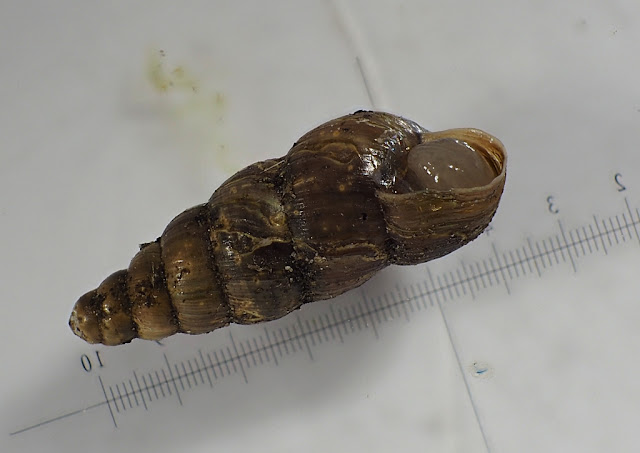...are bloody hard to identify. A couple of new species for me and the patch in the last few days. I must turn over stones in the bird crop field pretty regularly, I'm not sure I had ever turned the particular stone over before. I knew I'd not seen this species before straight away.
 |
| Vitrina pelludida or Winter Slug-snail, two different animals. |
That's the easy ones sorted then.
 |
| Balea sarsii or Tree Snail. |
Split from Balea perversa in 2006, originally named Balea heydeni, but the name was changed to Balea sarsii. And the English name Tree Snail is sometimes given to its cogena B. perversa, that is often referred to as Wall Snail.
These snails are sinistral, they spiral leftways, Comrade Snail might be a better name. So once you get your head around that they are easy to get to the species pair. Getting to species is awkward though. It would seem to be about experience of viewing the shape and subtle differences in shellsculpture and colour. However, B. perversa usually has an obvious tooth in the mouth of the shell, so that will help. I don't like "usually" though.
I'd found some dead shells at Happy Valley the other day. Today I looked in similar habitat in the Wee Wood and bingo. A nice little cell of seven live ones, then another further along (that one had split to form the Marxist-Lenninist splinter, more politically pure party). I'm reasonably sure this is B. sarsii, help procured online, thanks MS.
Also at Happy Valley these Aegopinella nitidula (I hope).
 |
| Aegopinella nitidula. |
I have often felt not especially sure about this species, but pretty sure I'm right. See previous post also.




2 comments:
I'd go with Balea sarsii for your snail. I get both here on Skye, but sarsii is by far the commoner and usually in woodland areas, especially on fenceposts near trees as well as under loose bark. I only regularly see perversa here in drystone walls. I see sarsii as being somehow more curvy and rounded and perversa being longer, sleeker and more drawn out in profile. Not very helpful, I guess, but it's relatively easy to see after a while (assuming you have both present up there?)
Thanks Gibster, apparently both species are present here, so now I need to find the other one. It would be cool to find it on the patch, plenty of dry stone walls.
Post a Comment